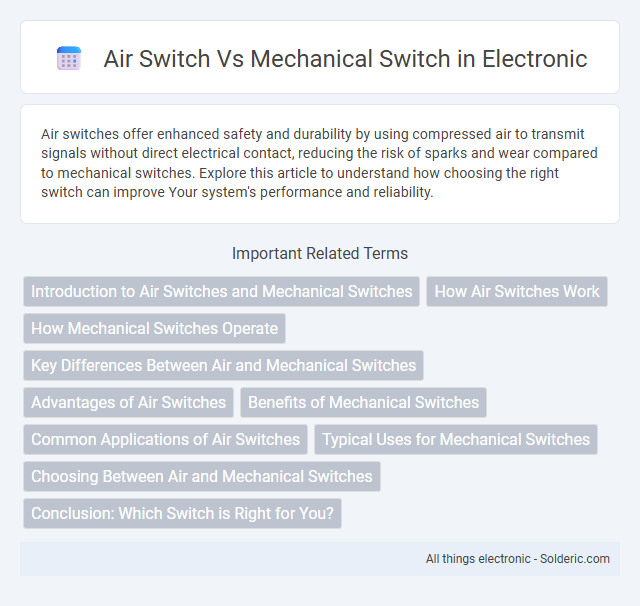Air switches offer enhanced safety and durability by using compressed air to transmit signals without direct electrical contact, reducing the risk of sparks and wear compared to mechanical switches. Explore this article to understand how choosing the right switch can improve Your system's performance and reliability.
Comparison Table
| Feature | Air Switch | Mechanical Switch |
|---|---|---|
| Operation Method | Uses compressed air to activate the switch | Direct mechanical movement to open or close the circuit |
| Durability | High resistance to moisture and corrosion | Prone to wear and tear from mechanical friction |
| Installation Location | Can be installed remotely due to air tube connection | Typically installed directly on the device or panel |
| Safety | Isolated electrical components reduce shock risk | Electrical components exposed to direct contact |
| Cost | Generally higher due to specialized components | Lower cost and simpler design |
| Typical Applications | Used in wet environments like kitchens and bathrooms | Common in general electrical apparatus and switches |
Introduction to Air Switches and Mechanical Switches
Air switches use an air-based pneumatic mechanism to activate electrical circuits, offering enhanced safety in wet or hazardous environments by isolating electrical contacts. Mechanical switches rely on physical metal contacts to open or close a circuit, providing direct and reliable control but can wear out due to friction and exposure. Your choice between air and mechanical switches depends on the application's need for durability, environmental resistance, and safety requirements.
How Air Switches Work
Air switches operate by using a burst of compressed air to activate an electrical circuit, providing a safe, low-voltage control mechanism ideal for wet or hazardous environments. When the user presses the button, air pressure travels through a flexible tube to a pneumatic switch, which then closes or opens the electronic contact. This design eliminates direct electrical connections at the switch interface, enhancing safety and durability compared to mechanical switches.
How Mechanical Switches Operate
Mechanical switches operate by physically opening or closing electrical contacts through the movement of a lever or button, which completes or interrupts the circuit. These switches rely on metallic components that create a direct connection, ensuring low resistance and reliable conductivity when engaged. Your choice of mechanical switch will impact durability and tactile feedback based on materials and design.
Key Differences Between Air and Mechanical Switches
Air switches use compressed air to actuate electrical contacts, providing electrical isolation and reducing fire hazards, while mechanical switches rely on physical contact between metal components to complete circuits. Mechanical switches typically offer faster response times and simpler construction but are prone to wear and sparking due to direct contact. Air switches are more durable for high-power or hazardous environments, ensuring safer operation in industrial applications.
Advantages of Air Switches
Air switches offer superior durability and safety by using a non-contact mechanism to control electrical circuits, reducing wear and the risk of electric shock. You benefit from enhanced reliability in environments prone to moisture or dust, as air switches are less susceptible to corrosion compared to mechanical switches. Their silent operation and low maintenance requirements make air switches an ideal choice for sensitive or high-use applications.
Benefits of Mechanical Switches
Mechanical switches offer superior durability and tactile feedback compared to air switches, making them ideal for users who prioritize responsiveness and longevity. The distinct audible click and precise actuation enhance user experience in gaming and typing scenarios, where accuracy is crucial. Your choice of mechanical switches ensures consistent performance through millions of reliable keystrokes, supporting intense and prolonged use.
Common Applications of Air Switches
Air switches are commonly used in environments requiring safe and reliable control of electrical devices, such as garbage disposals, spa pumps, and kitchen appliances, where moisture and water exposure are prevalent. Their sealed design prevents electrical shock, making them ideal for wet or damp settings, including commercial kitchens and bathroom fixtures. You benefit from enhanced safety and durability when choosing air switches for applications sensitive to water and humidity.
Typical Uses for Mechanical Switches
Mechanical switches are commonly used in household appliances, industrial machinery, and automotive controls due to their durability and tactile feedback. They excel in applications requiring reliable manual operation, such as light switches, keyboard keys, and control panels. Their simple design enables easy installation and maintenance in various low-voltage and high-voltage environments.
Choosing Between Air and Mechanical Switches
Choosing between air switches and mechanical switches depends on your application's requirements for durability, responsiveness, and environmental resistance. Air switches use pneumatic pressure changes to actuate signals, offering superior reliability in wet or dirty conditions where mechanical parts can wear out. Your decision should weigh factors like installation complexity, maintenance needs, and the operational environment to ensure optimum performance.
Conclusion: Which Switch is Right for You?
Air switches offer enhanced safety and durability by using an air pressure mechanism to activate circuits without direct electrical contact, making them ideal for wet or hazardous environments. Mechanical switches provide tactile feedback and straightforward installation, suitable for applications where reliability and simplicity are priorities. Your choice depends on whether you prioritize safety and longevity (air switch) or cost-effectiveness and ease of use (mechanical switch).
Air switch vs Mechanical switch Infographic

 solderic.com
solderic.com